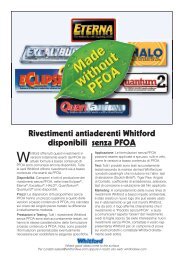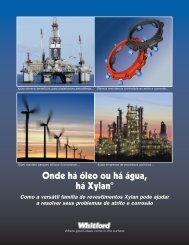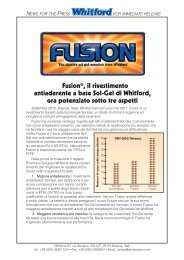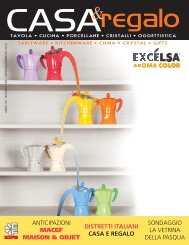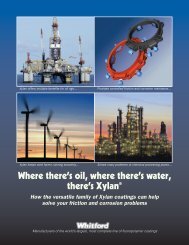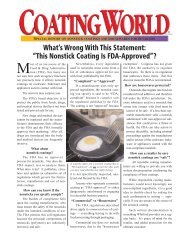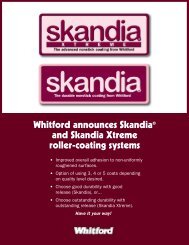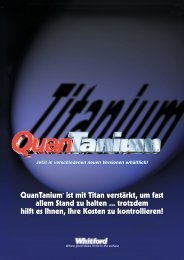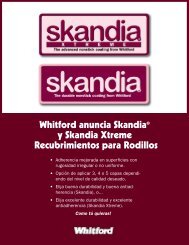Literature PDF
Literature PDF
Literature PDF
- No tags were found...
Create successful ePaper yourself
Turn your PDF publications into a flip-book with our unique Google optimized e-Paper software.
Curing: Process of bonding or fusing a coatingto a substrate. Pages 1, 4, 18, 21, 22, 2526, 30, 37.Dielectric strength: Ability of a coating toresist the passage of direct electric current.Page 13.Dip/spin: Coating application technique inwhich small parts are placed in a basket that islowered into a coating bath, then raised andspun to remove excess coating. An economicalsystem for coating high volumes of small parts.Pages 3, 4, 11, 20, 21.Dip/spinning is ideal for small, complicated parts.Dry (solid) lubricants: Solid materials such asPTFE, Molybdenum Disulfide (MoS 2 ) and graphitethat have low coefficients of friction. Pages 2, 7.Elastomers: Any of various elastic substancesresembling rubber. Page 18.Electrostatic spray: Spray applicationprocess in which the coating and part to becoated are oppositely charged; process providesexcellent “wrap” of coating around thepart, even on sides opposite the spray gun.Page 21.Engineering plastics: Plastic resins that havehigh-performance properties such as high temperaturestability, hot hardness, abrasion resistance,and corrosion resistance. Page 2.EPDM: Ethylene-propylene-diene monomer,an elastomeric substitute for rubber used extensivelyin the automotive industry. Pages 18, 25.Epoxy: A flexible resin, usually thermosetting,made by polymerization of an epoxide and usedchiefly in coatings and adhesives. Pages 18, 35.Fabrics: Woven or nonwoven materials thatcan be impregnated with fluoropolymer coatingsto impart low friction, improve chemical resistance,and increase strength. Pages 18, 19, 21,28.FEP (fluorinated ethylene propylene): A thermoplasticmember of the fluoropolymer family ofplastics. FEP has the best nonstick and nonwettingproperties of these materials. Pages 3, 4,13.Fillers: Pigments and other solids used toalter properties of coatings. Pages 3, 4, 17, 34.Flashing: A brief subcure (at lower temperaturesthan the final cure) to drive off solvents/carriers prior to full cure. This helps preventbubbling. See “Partial cure.” Pages 1, 21, 22.Fluoropolymers: Family of engineering plasticscontaining fluorine, characterized by highthermal stability, almost universal chemical resistanceand low friction. Pages 2, 4,18, 23, 27.Fretting: Wear phenomenon caused by vibrationamong tightly clamped or fastened surfaces.Pages 10, 11, 19.Friction (dynamic): Resistance to continuedmotion between two surfaces; also known assliding friction. Pages 1, 2, 3, 4, 5, 6, 7, 9, 11,12, 13, 15, 16, 18, 23, 24, 25, 26, 28, 33, 34.Friction (static): Resistance to initial motionbetween two surfaces. Pages 1, 2, 3, 4, 5, 6, 7,9, 11, 12, 13, 15, 16, 18, 23, 24, 25, 26, 28, 33,34.Graphite: Carbon-based dry lubricant that ispreferred for high-temperature applications.Pages 2, 3, 4, 7, 13, 34.Hot hardness: Ability of a coating to retainhardness and wear resistance at elevated temperatures.Usually a characteristic of coatingsbased on thermosetting resin binders. Page 38.HVLP (high volume, low pressure): A type ofspray gun utilizing high pressure in combinationwith low air velocity to increase transfer efficiencyand reduce air pollution. Pages 4, 20.Hydrogen embrittlement: Embrittlement ofcarbon steel caused by absorption of atomichydrogen in plating, pickling or acid cleaningprocesses. Pages 11, 19.Kesternich: German scientist who developedthe Kesternich Cabinet and test method used for39



